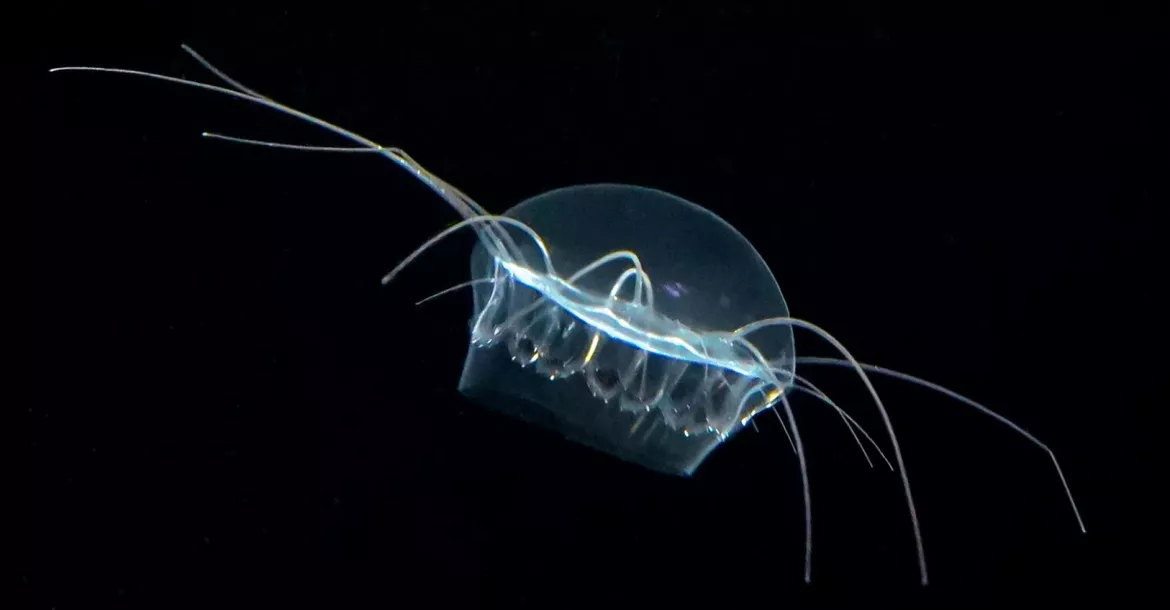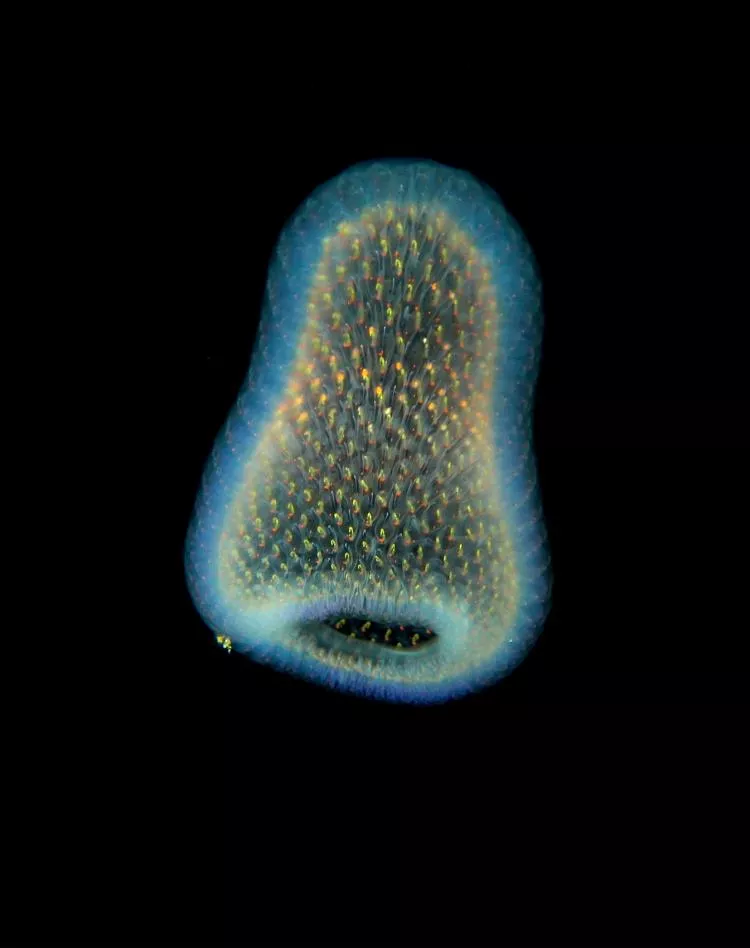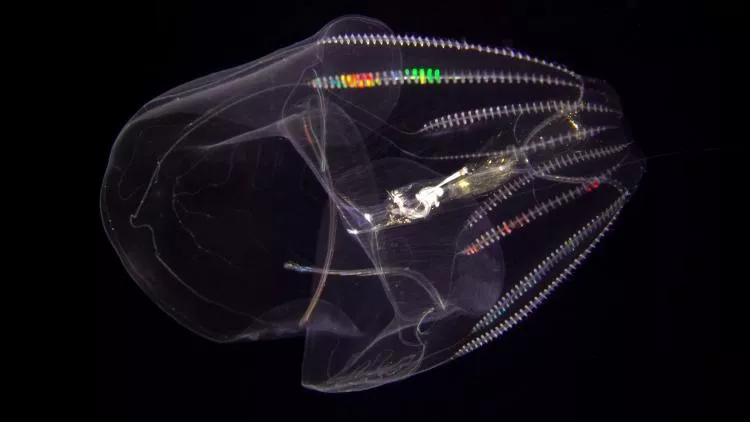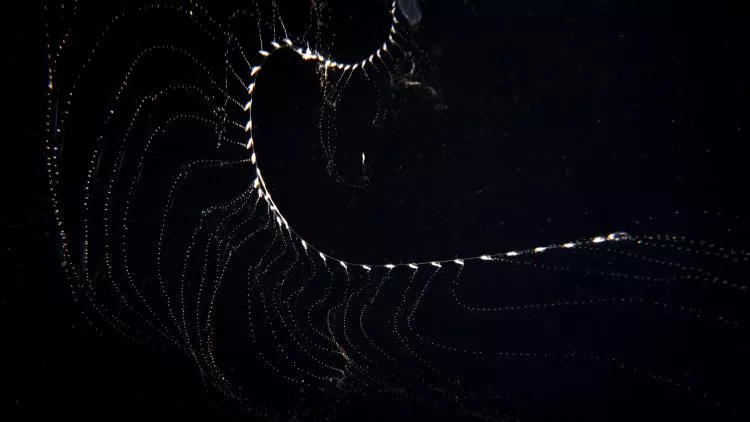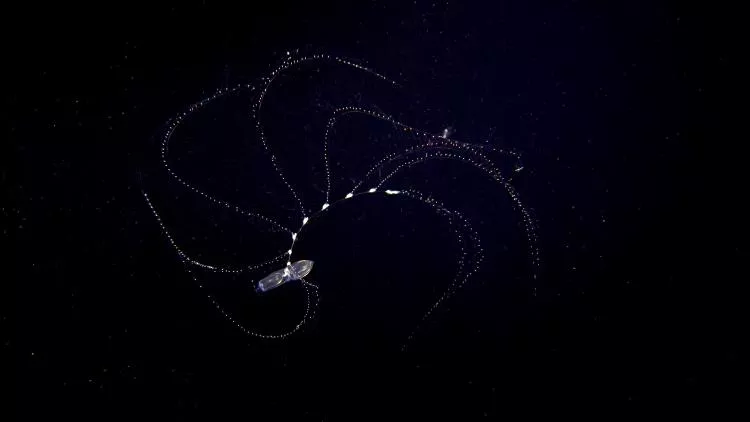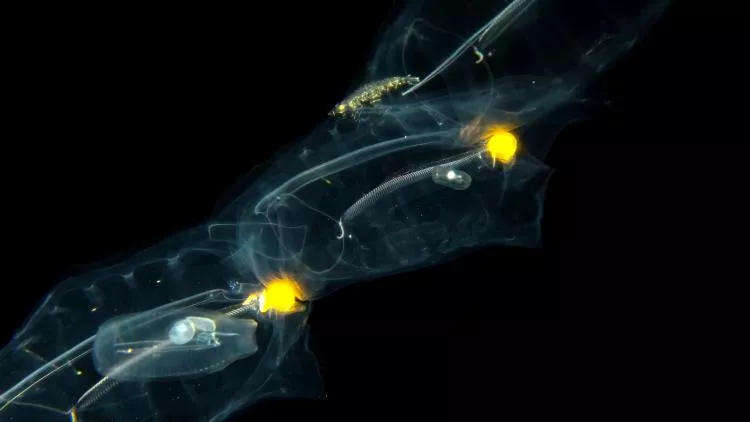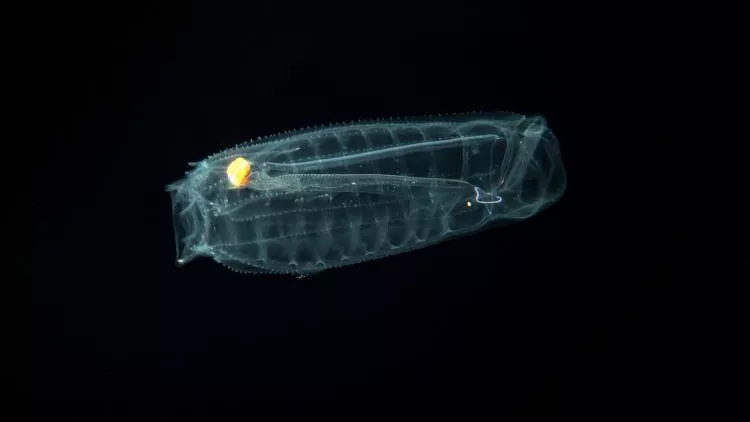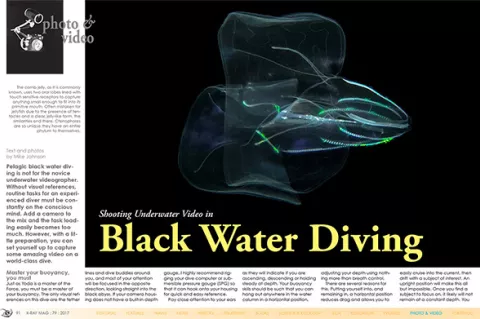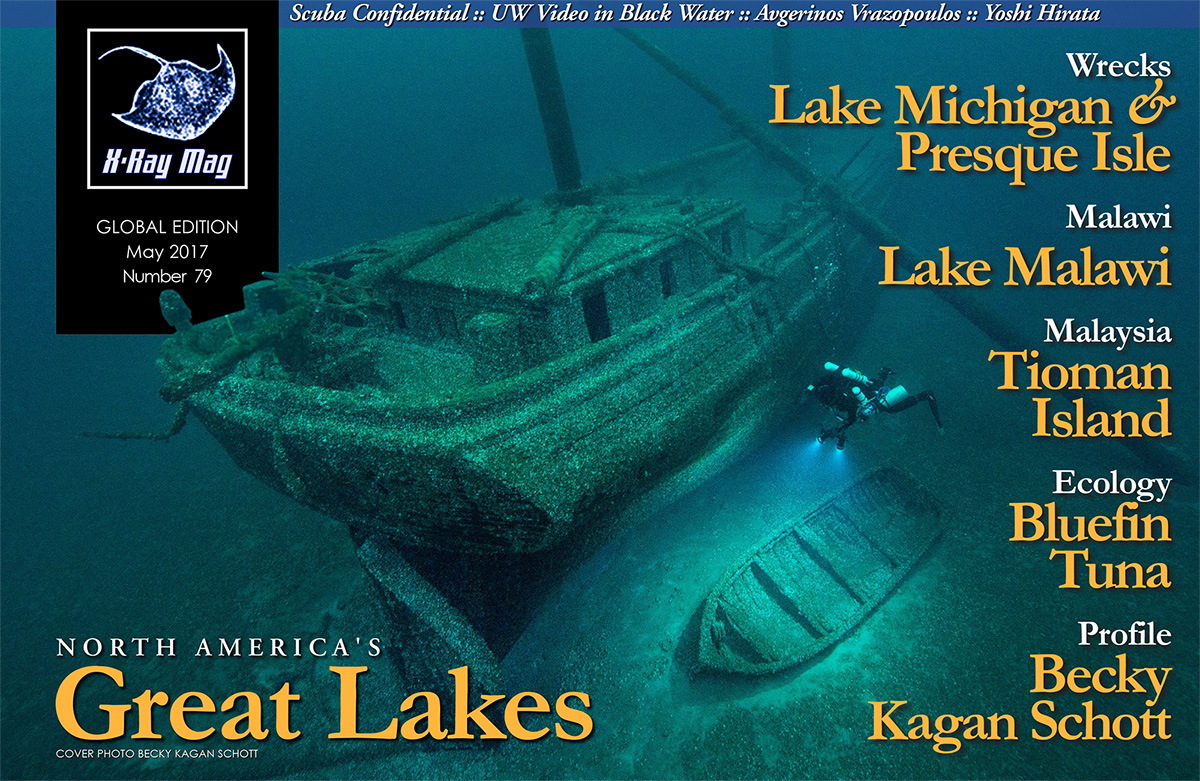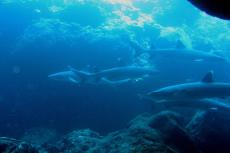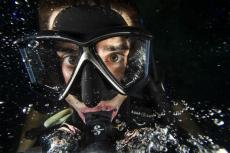Pelagic black water diving is not for the novice underwater videographer. Without visual references, routine tasks, even for an experienced diver, must be constantly on the conscious mind. Add a camera to the mix and the task loading easily becomes too much. However, with a little preparation, you can set yourself up to capture some amazing video on a world-class dive.
Contributed by
Factfile
Mike Johnson is a director of photography specializing in adventure and outdoor video productions.
He travels the world shooting and producing television shows, documentaries and the occasional corporate video.
Johnson is also a passionate diver, working in his spare time as a PADI divemaster.
Follow him on Facebook @mikejohnsonvideopro and on Instagram @mikejohnsonvideo.
Master your buoyancy, you must
Just as Yoda is a master of the Force, you must be a master of your buoyancy. The only visual references on this dive are the tether lines and dive buddies around you, and most of your attention will be focused in the opposite direction, looking straight into the black abyss. If your camera housing does not have a built-in depth gauge, I highly recommend rigging your dive computer or submersible pressure gauge (SPG) so that it can hook onto your housing for quick and easy reference.
Pay close attention to your ears as they will indicate if you are ascending, descending or holding steady at depth. Your buoyancy skills should be such that you can hang out anywhere in the water column in a horizontal position, adjusting your depth with nothing more than breath control.
There are several reasons for this. Putting yourself into, and remaining in, a horizontal position reduces drag and allows you to easily cruise into the current, then drift with a subject of interest. An upright position will make this all but impossible. Once you find a subject to focus on, it likely will not remain at a constant depth. You can either hang out at an arbitrary depth, letting your subject pass on by, or move with it through the water column, thereby extending the amount of time you have to capture some amazing video.
Being able to adjust your depth solely with breath control will keep both hands on the camera, resulting in a nice steady shot. Continually reaching for your power inflator or dump valve will add fumbles and bobbles to your footage that cannot be smoothed out with any stabilization plugin or software.
Stabilization
Speaking of stabilization, those nice buttery-smooth shots seen on National Geographic take a lot more practice than what is possible in even a week of diving (not to mention, many are shot in aquariums). There are several software options for post-production that will help get this look, but you will need to be sure to set up for success with the right settings in the camera.
The first step to successfully stabilizing footage in post-production is to eliminate motion blur. The Sony a7S II has a 5-axis stabilized image sensor that works wonders! Many current camera models offer features for image stabilization. Be sure to turn these features on, but also understand that optical stabilization works best. Digital stabilization will smooth out the image, but will not help to reduce motion blur.
With my a7S II, I shoot with a shutter speed set at three times my focal length. If using a camera without image stabilization, or one that does not provide optical stabilization on five axes, you will want to increase your shutter speed even further. The general rule in video is to set the shutter at twice the frame rate, so shooting at 24p would mean a shutter speed of 1/48. This is simply too slow to eliminate the motion blur from bobbing around in the water tracking an object a couple inches off your lens that is moving independently from yourself. Stabilizing footage that has too much motion blur may be smooth, but will look like the focus is constantly searching.
If your camera is 4K capable, shoot in 4K! Yes, this may require investing in a larger memory card to avoid running out of space halfway through the dive, but it is well worth the investment.
Frame subjects with a little more room around the edges than normal. Instead of editing in a 4K resolution project, edit the 4K footage into a 1920x1080 project. This will provide some space for the post-production stabilization to occur, and will allow you to crop as necessary without losing any quality. By scaling down the 4K footage to HD resolution, this will also reduce the appearance of any remaining motion blur and the digital noise created by shooting in a higher ISO (gain) setting.
Lens choice plays a major role in stabilization. Rolling up to the boat with a 100mm macro lens is very tempting indeed. For shooting stills, this is a great choice! With video, on the other hand, the footage will be so shaky you may get seasick viewing it at your computer. The longer the focal length of your lens, the harder it is to hold steady. Try staying wider.
If shooting pelagic black water video for the first time, I recommend a macro lens with a focal length of 30mm or wider, especially if using a flat port. With a little experience, you may decide you want to bump up to 60mm, but breaking out the big guns on the first few dives is going to result in major disappointment when you play back the footage.
Exposure
Pelagic black water diving is one of those times when shooting in full manual exposure is encouraged. If you are not comfortable shooting in full manual, be sure to set some limits on the automatic settings of your camera.
One option the Sony a7S II allows for, which I found very handy, is manually setting both aperture and shutter speed while using auto ISO (gain). This produces much better results than shooting in Shutter Priority (for motion blur control) or Aperture Priority (for depth of field control) as you can lock in both, yet still do not have to manually adjust your exposure for every shot.
The time you have with each critter is extremely valuable. You may only get eight to 10 seconds before it moves out of reach, so every fraction of a second saved can be spent composing and holding a shot.
Because macro video (and photo) has a very shallow depth of field to begin with, stop down your aperture to somewhere around f/13. This will vary slightly based on image sensor size (larger image sensors have a shallower depth of field) and focal length. Photography captures a single moment in time, while video captures several seconds of time. Within these seconds, there is a lot of movement that takes place, so give yourself as much depth of field as you can get.
Within the automatic ISO setting on the a7S II, the camera allows both lower and upper limits. I set the lower limit to ISO 100 and the upper to ISO 12,800. ISO 12,800 sounds insanely high when compared to DSLRs like the Canon 5D series, which has been touted for its low light ability, but the a7S II does an amazing job at these higher sensitivities.
I have found through both test shoots and trial and error that ISO 12,800 introduces an acceptable level of noise to the image while remaining usable on professional production standards. If you choose to shoot with auto ISO (or gain), be sure to look for an upper limit restriction and take the time to research what is acceptable for your specific camera model. Every camera is different, so do not just take my word for it. It would be an awful feeling to get to a computer after the dive to find that all your footage is useless because the ISO was set too high.
If you choose to shoot with ANY automatic exposure settings, be sure to set your exposure value (EV) to -2. With specs of light on a black background, the exposure meter in every camera will tend to expose too high to compensate for the massive amount of darkness.
Another option, if your camera has this feature, is to change the metering mode to spot. In this mode, the camera will meter the exposure based on a small area usually in the center of the frame. However, this does not consistently produce good results as many creatures will spread out across the frame, without a good exposure reference in the middle.
The time you have with each critter is extremely valuable. You may only get eight to 10 seconds before it moves out of reach, so every fraction of a second saved can be spent composing and holding a shot.
Lighting
With exposure comes lighting. There are many species on the pelagic black water dive that produce their own bioluminescent light. The output is very dim and not enough to fuel many camera sensors. Shooting with video lights is a must. Shoot with one, two or even several lights.
Regardless of how many lights you choose to shoot with, they should be angled from the side, top or bottom and set to fill the area where your macro lens is focusing on. I used two Light & Motion Sola 2000 Video lights, with one positioned at 9 o’clock and the second at roughly 1 o’clock. The light at 9 o’clock I set at 1000 lumen output, and the light at 1 o’clock I set at 500 lumen output. This did a really nice job of illuminating any translucent bodies, yet was still not too bright to overpower most of the bioluminescence.
With a video camera in your hand, you can just as easily become the most despised diver as you can the most liked diver. Taking over the entire space under the boat and constantly flagging other divers with your lights may very well end your dive early. Being respectful of the other divers by keeping within your space and not allowing your video lights to shine in their faces will possibly result in footage of some cool creatures you missed, but someone else pointed out to you.
Focus
Solid focus is critical to any good video. Increasing your depth of field by stopping down the aperture is a great second step to good focus. The first is a lens with fast auto focus paired with a camera with a fast auto focus sensor.
Many black water photographers recommend using manual focus because instant, single shot auto focus on a small subject can be very difficult to obtain. In video, we deal with continuous auto focus, and this is a must for all but the most experienced underwater videographers. Even at f/13 or f/20, depth of field with a macro lens may only be one or two inches. This allows for very little wiggle room to compensate for two independently moving objects, namely the subject and camera.
Shooting in manual focus means the camera must remain at the exact same distance from the subject throughout the entire duration for the shot to be in focus. A solid lens/camera combination will allow for much more room in tracking the subject and will result in longer usable shots.
Getting the shot
Your camera rig is set, tested and ready to go. Your buoyancy is so good your dive buddy swears you are a fish. Half of the challenge is now complete. The second half is acquiring some amazing footage. The technique for this is as unique as the dive itself.
The first task is to figure out which way the current is moving. Oftentimes, it will be subtle. Hover next to your drop line and slowly look around, searching out the direction in which the plankton soup is moving straight towards you. Swim straight into the current as far as the tether will allow, holding your camera in the ready position. Scan the area in front of you for anything bigger than a speck of dust. It takes a few minutes to figure out exactly what to look for, but once you do, there is stuff everywhere!
Avoid the temptation to move quickly from one subject to the next. Rather, pick one to focus on. Find it out in front of you far enough that you have time to hit “Record” and frame the shot. If you must swim to a subject, do not swim too fast, as you can very easily overshoot and miss an opportunity.
Keep in mind these creatures are powerless against the current. Turbulence created by you moving through the water can very easily send the one you are after into a tumble that is both unnatural and nearly impossible to follow.
Once you lock onto a subject, stay with it by hovering motionless as you both drift along. Hold the shot steady until you can no longer follow the subject.
The best approach I found is to let the subject drift underneath you. This is where Jedi-like buoyancy skills come into play. If the subject goes above you, you will not only get your exhaust bubbles in the shot, the turbulence created by the bubbles will make your subject look like it is in a washing machine. With breath control, position yourself just above, so as the subject drifts by, you can follow until the tether holds you back.
Do not be afraid to ascend or descend through the water column to stay with the subject. However, do be careful to do so with great control. Ascending too fast could result in decompression illness, and descending too fast could result in a blown eardrum. With a little practice, you can expect to have eight to 10 seconds for every subject you are able to lock in on.
My recommendation for shot composition for the first few dives is to keep it simple. Creative, unique angles are a fantastic goal to have, but add an entirely new layer of complexity on an already complicated dive. Try to focus instead on getting steady, in-focus shots of whatever angle is presented to you. In my opinion, it is better to walk away with something “average” than to walk away with a failed experiment. After all, the “average” shots in a pelagic black water dive are not that average! ■

